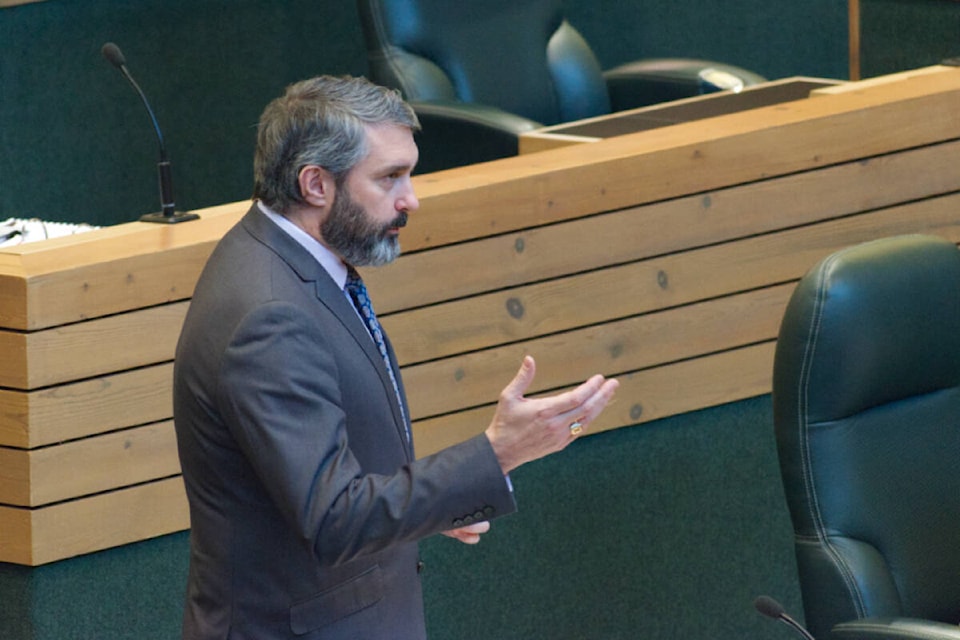The Yukon has a $55-million surplus on a spending and revenue base of around $1.7 billion, according to the territorial government’s recent financial update.
Premier and Finance Minister Sandy Silver tabled the 2021-22 public accounts — a financial statement and analysis document — in the Yukon Legislative Assembly on Oct. 27.
The document states the COVID-19 pandemic had a “significant” but less severe impact in 2021-22 compared to the previous year, which saw the “most severe” impact.
In the document, the difference between the actual surplus and the expected surplus of $21.2 million presented in the 2021-22 budget is due to higher revenues offset by higher than anticipated expenses.
The document mentions the amount of money coming in was higher than budgeted largely due to higher than anticipated transfers from the federal government and higher tax revenue, while funding and service level agreements with other parties led to less revenue than predicted.
Total revenues went up by $114 million or 6.9 per cent compared to the previous year and total expenses climbed by $103.9 million or 6.4 per cent.
The document notes the net financial assets to GDP ratio is low, which indicates the Yukon government has not put “excessive demands” on the economy. A downward trend since 2015 implies there is “room for the introduction of further revenue sources for the government without causing severe hardship in the economy,” reads the report.
The document indicates the Yukon government has a total debt of $216.4 million, which is 27 per cent of the permitted limit.
Revenues from the sale of land went down $27.7 million or 77.7 per cent from the previous year according to the document.
The largest increase in expenses was seen in the natural resources function, which is up $61.5 million or close to 60 per cent from the previous year. Business, tourism and culture expenses were down by $3.5 million or just over five per cent.
A chart in the document shows personnel makes up 42 per cent of expenses.
The Yukon government’s net financial assets were $163.5 million — a decrease of $19.3 million — which the document notes is a key indicator that shows the government has financial assets on hand to finance future operations.
Officials from Canada’s auditor general’s office, which audits the consolidated financial statements, and the department of Finance appeared as witnesses at a public hearing on Dec. 7 held by the Standing Committee on Public Accounts.
Opposition parties respond to public accounts
The Yukon Party issued a release on Dec. 12 that focuses on the department of Community Service’s budget of $118.8 million, of which the Yukon government spent only $86.1 million, according to the document.
The release cites the shortfall was in lot development in Whitehorse and in communities.
“We have repeatedly pointed out the Liberals’ delays in lot development and how it is contributing to the housing crisis,” housing and lot development critic Yvonne Clarke, who is MLA for Porter Creek Centre, said in the release.
“The minister has bragged he was making ‘record-breaking’ investments, but Finance officials have now confirmed millions of dollars have gone unspent. Yukoners and builders need these lots to build more homes to address our housing crisis.”
In the release, the official opposition said it has previously suggested the Yukon government identify parcels of land that can be developed by the private sector and provide money to municipalities to speed up zoning and planning.
A Dec. 14 release from the Yukon Party criticizes $94 million unspent on capital projects. The actual amount spent during the fiscal year was $343.3 million out of a budgeted total of $437.3 million.
“Contractors, First Nations, municipalities and Yukoners plan for the season based on the expenditures outlined in the capital budget each year,” said highways and public works critic Stacey Hassard, who is MLA for Pelly-Nisutlin.
“The past few years we have seen numerous projects that Yukoners are relying on to address critical issues delayed, over budget or left incomplete due to government delays, cancellations or a lack of oversight. Yukoners are growing frustrated as this Liberal government fails to deliver on their promises.”
In the release, the Yukon Party suggests the Yukon government identify seasonally dependent infrastructure projects and develop a process to award contracts before the building season begins to enable contractors to go into the spring hiring season knowing projects that will be on the go.
In a Dec. 12 release, the Yukon NDP outlined its wish list for spending the surplus: invest in health-care worker retention and attraction, open a public walk-in medical clinic, build more Yukon Housing Corporation units, implement the NDP’s proposed anti-inflation measures and fund free transit in Whitehorse.
“Inflation is making life more difficult for Yukoners. Widespread shortages are threatening our healthcare, our education system, our social services and more. Now is not the time to cut back on spending,” Yukon NDP Leader Kate White said in the release.
“Yukoners are struggling every day — to buy groceries and pay rent, to afford medication, to save for retirement or their children’s education, or even to find a place to call home. The government should be using leftover public money to help people, not to sit in the bank.”
Contact Dana Hatherly at dana.hatherly@yukon-news.com
